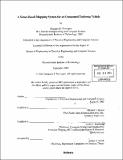| dc.contributor.advisor | Michael J. Ricard and Leslie P. Kaelbling. | en_US |
| dc.contributor.author | Nervegna, Margaret F. (Margaret Frances), 1979- | en_US |
| dc.contributor.other | Massachusetts Institute of Technology. Dept. of Electrical Engineering and Computer Science. | en_US |
| dc.date.accessioned | 2006-03-24T16:11:46Z | |
| dc.date.available | 2006-03-24T16:11:46Z | |
| dc.date.copyright | 2002 | en_US |
| dc.date.issued | 2002 | en_US |
| dc.identifier.uri | http://hdl.handle.net/1721.1/29651 | |
| dc.description | Thesis (M.Eng.)--Massachusetts Institute of Technology, Dept. of Electrical Engineering and Computer Science, 2002. | en_US |
| dc.description | Includes bibliographical references (p. 115-118). | en_US |
| dc.description.abstract | An unmanned undersea vehicle (UUV) must operate autonomously in a complex, dynamic environment and react intelligently to changing tactical, environmental, and mission variables with no outside intervention. To support these real-time, adaptive mission capabilities, the building and updating of an efficient and accurate map of the tactical scene is critical. The challenges are to obtain useful and comprehensive information about the environment, to represent and fuse this data into an on-board map, to update the map in real-time when new data is discovered, and to save the map for future use while maintaining both efficiency and accuracy. This thesis presents the design and implementation of a sonar-based mapping system for a UUV, and discusses the elements of the mapping system design: representation of static and dynamic obstacles in a mapping system, the need for efficient data structures, the incorporation of sonar measurement uncertainty, and the assimilation of new information into the map. The mapping system consists of a static obstacle map that stores information about stationary objects and a dynamic obstacle map that stores information about moving objects in the underwater environment. The static obstacle map consists of a local map that represents the immediate mission area and a global map that represents the entire mission area. The combination of the separate maps forms an integrated mapping system that represents the UUV's tactical scene, supports a query for the presence or absence of an obstacle at any location, time, and level of certainty, and as such, can be used to support the UUV's mission objectives. This thesis also discusses modeling of noise in the sonar measurements. Since the mapping system must handle noisy sonar measurements, a model of a noisy sonar measurement is an imperative part of the sonar simulation and the validation of the mapping system. | en_US |
| dc.description.statementofresponsibility | by Margaret F. Nervegna. | en_US |
| dc.format.extent | 118 p. | en_US |
| dc.format.extent | 4942884 bytes | |
| dc.format.extent | 4942692 bytes | |
| dc.format.mimetype | application/pdf | |
| dc.format.mimetype | application/pdf | |
| dc.language.iso | eng | en_US |
| dc.publisher | Massachusetts Institute of Technology | en_US |
| dc.rights | M.I.T. theses are protected by copyright. They may be viewed from this source for any purpose, but reproduction or distribution in any format is prohibited without written permission. See provided URL for inquiries about permission. | en_US |
| dc.rights.uri | http://dspace.mit.edu/handle/1721.1/7582 | |
| dc.subject | Electrical Engineering and Computer Science. | en_US |
| dc.title | A sonar-based mapping system for an unmanned undersea vehicle | en_US |
| dc.type | Thesis | en_US |
| dc.description.degree | M.Eng. | en_US |
| dc.contributor.department | Massachusetts Institute of Technology. Department of Electrical Engineering and Computer Science | |
| dc.identifier.oclc | 53710807 | en_US |
